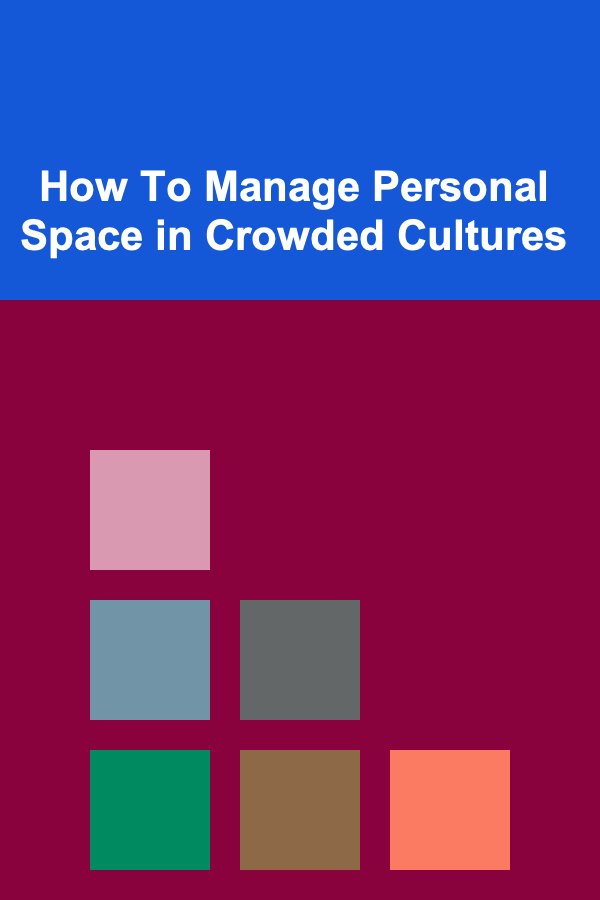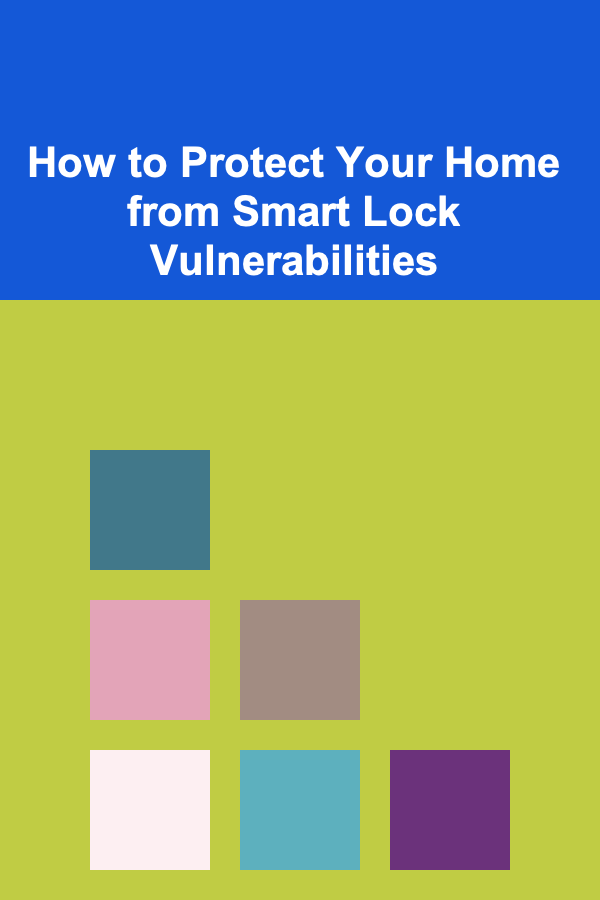
How To Manage Personal Space in Crowded Cultures
ebook include PDF & Audio bundle (Micro Guide)
$12.99$9.99
Limited Time Offer! Order within the next:

In a world of rapid urbanization, bustling cities, and constant interactions, personal space has become an increasingly valuable commodity. Yet, the concept of personal space isn't universal; it is shaped by culture, geography, and societal norms. In crowded cultures, where people are often living in close proximity to each other, managing personal space can be a delicate balancing act. Understanding how to navigate personal space in such environments is key to fostering positive social interactions, maintaining mental well-being, and avoiding cultural faux pas.
In this article, we will explore the concept of personal space in crowded cultures, its cultural variations, the challenges people face, and practical strategies to manage personal space effectively in such environments.
The Concept of Personal Space
Personal space refers to the physical area surrounding an individual that they consider their own. It is the invisible "bubble" that people need around themselves in order to feel comfortable and secure. The size of this bubble varies depending on cultural background, social norms, individual preferences, and even the context of the interaction.
For instance, in some cultures, people prefer a large amount of space between themselves and others during social interactions, while in others, physical closeness is expected and viewed as a sign of friendliness or trust. In crowded cultures, the challenge lies in the fact that personal space is often compressed, and individuals are required to adapt to the spatial constraints of their environment.
How Personal Space Varies Across Cultures
The way people perceive and use personal space differs significantly between cultures. The concept of personal space is often linked to the broader cultural values of that society. These differences can be broadly categorized into two types of proximity:
- High-context cultures: These cultures tend to be more collectivistic and place high value on interpersonal relationships. People in such cultures often feel comfortable being physically close to each other and may not perceive it as an invasion of personal space. Examples of high-context cultures include many Asian, Mediterranean, and Latin American countries.
- Low-context cultures: These cultures value individualism and personal autonomy, which often leads to a greater need for personal space. People from low-context cultures typically prefer more distance in interactions and may feel uncomfortable if their personal space is encroached upon. Countries like the United States, Canada, and most Western European nations tend to be more low-context.
Proxemics: The Study of Space in Human Interaction
The study of personal space is called proxemics, a term coined by anthropologist Edward T. Hall in the 1960s. Hall's work on proxemics identified four distinct zones of personal space:
- Intimate Space: This zone typically extends up to 18 inches (45 cm) from the body. It is reserved for close relationships, such as family members, romantic partners, and close friends.
- Personal Space: This zone ranges from 18 inches to 4 feet (45 cm to 1.2 meters) and is appropriate for conversations with friends and acquaintances.
- Social Space: This zone extends from 4 to 12 feet (1.2 to 3.6 meters) and is common for interactions in formal settings, such as business meetings or social gatherings.
- Public Space: This zone is more than 12 feet (3.6 meters) and is typical of public settings, such as lectures, speeches, or large crowds.
In crowded cultures, the boundary between these zones can become blurred, leading to discomfort or misunderstandings. For example, in some Asian cultures, people may feel comfortable in intimate spaces even with acquaintances, whereas in Western cultures, the same proximity might be perceived as intrusive.
The Challenges of Personal Space in Crowded Cultures
In densely populated areas, personal space is often limited. For example, in megacities like Tokyo, New York, or Mumbai, the sheer number of people living in a small geographic area means that physical space is in high demand. This overcrowding can create a range of challenges, including:
1. Social Friction
One of the most immediate effects of crowded environments is social friction. People often find themselves in close proximity to others, whether on public transport, in elevators, or in tightly packed markets. This lack of space can result in discomfort, irritation, or even conflict. In societies where personal space is highly valued, such as in many Western countries, people may become frustrated if their space is invaded, even unintentionally.
2. Mental and Emotional Stress
Constant exposure to overcrowded environments can also lead to mental and emotional stress. Individuals may feel claustrophobic, anxious, or overwhelmed due to the lack of personal space. The brain associates personal space with safety and security, and when this space is compromised, stress levels can increase. In extreme cases, this can lead to more severe mental health issues, such as anxiety disorders or depression.
3. Physical Health Concerns
The lack of personal space can also affect physical health. In crowded public spaces, the risk of exposure to infectious diseases increases. Proximity to others in such situations means that germs and viruses can spread more easily. For example, in densely populated cities, public transportation is a common site for people to come into close contact with one another, heightening the risk of illness transmission.
4. Cultural Misunderstandings
In multicultural societies, individuals from different cultural backgrounds may have different expectations regarding personal space. For example, someone from a culture that values personal space might be taken aback by a person from a culture that is more physically expressive and accustomed to closer proximity. These cultural misunderstandings can lead to uncomfortable social interactions and even conflicts if not properly managed.
Strategies for Managing Personal Space in Crowded Cultures
Despite the challenges, there are several strategies individuals can use to manage personal space in crowded cultures effectively. These strategies involve both practical techniques and a deeper understanding of cultural norms. Below are some tips for navigating personal space in crowded environments:
1. Be Aware of Cultural Differences
Understanding cultural differences is essential when managing personal space. In cultures where close physical proximity is the norm, it is important to be mindful of these cultural expectations and adjust accordingly. Conversely, in cultures where personal space is highly valued, respecting the physical boundaries of others can foster positive social interactions.
For example, in Japan, it is common for people to maintain physical closeness during conversations, particularly in social or informal settings. On the other hand, in countries like the United States, personal space is often much larger, and standing too close to someone may be interpreted as intrusive or aggressive.
2. Use Non-verbal Cues to Communicate Boundaries
Non-verbal communication plays a significant role in managing personal space. In crowded environments, people often rely on body language to signal their comfort or discomfort with physical proximity. Simple gestures such as stepping back, crossing arms, or leaning away from someone can indicate that your personal space is being encroached upon. In some cases, people may use eye contact or facial expressions to express discomfort.
Being aware of these subtle cues can help avoid misunderstandings and allow individuals to maintain a comfortable distance without needing to verbally address the issue.
3. Utilize Public Space Wisely
When in crowded spaces, such as public transportation or busy streets, it's important to be conscious of how you use the space around you. For instance, standing in the middle of a crowded sidewalk can block the flow of people, making the environment more stressful for others. By being mindful of where you stand or how you position yourself in these spaces, you contribute to a smoother, more comfortable interaction with others.
In public transport systems, especially in cities like New York or Tokyo, people are often forced to stand in close proximity to one another. In such situations, maintaining politeness and avoiding unnecessary physical contact can help reduce discomfort. Standing at a slight angle or holding onto a pole with a comfortable grip can minimize direct physical contact with others.
4. Create Personal Space in Small Areas
While it's difficult to control the amount of space in crowded settings, there are strategies for creating personal space within your immediate environment. For example, on public transport, you can try to position yourself in a way that minimizes direct contact with others. This could involve standing in a corner, sitting with your arms folded, or positioning your bags or personal belongings in a way that signals you need space.
If you are in a busy area, such as a marketplace or event, positioning yourself at the periphery of the crowd or finding a more open area can help you reclaim a sense of personal space.
5. Take Breaks from Crowded Environments
In environments where personal space is consistently compromised, it's important to take periodic breaks. Whether it's stepping out of a crowded café, taking a walk outside, or retreating to a quiet room, taking time to recharge can help you manage stress and prevent feelings of being overwhelmed. Regular breaks from crowded spaces give your mind and body a chance to relax and restore a sense of personal autonomy.
6. Practice Mindfulness and Stress-Relief Techniques
Finally, cultivating mindfulness and practicing stress-relief techniques can help individuals manage their reactions to crowded spaces. Techniques such as deep breathing, meditation, or simply focusing on the present moment can reduce feelings of anxiety or discomfort when dealing with overcrowded environments.
Mindfulness helps individuals remain calm and centered, even when external factors---such as a lack of personal space---trigger stress. By focusing on your breath or engaging in positive self-talk, you can reduce the physiological response to crowdedness and maintain a more balanced emotional state.
Conclusion
Managing personal space in crowded cultures is an essential skill that requires cultural awareness, patience, and the ability to adapt. While personal space is a deeply ingrained concept, crowded environments often necessitate adjustments to one's expectations and behaviors. By understanding the cultural norms of the environment, using non-verbal cues to communicate boundaries, and practicing strategies to create personal space, individuals can navigate crowded spaces with greater ease and comfort. Ultimately, respecting personal space in crowded cultures fosters positive social interactions, reduces stress, and helps individuals maintain their well-being in bustling urban environments.

How to Make Money Online as a Veterinarian: 10 Actionable Ideas
Read More
How to Optimize Your Workspace with Ergonomic Solutions
Read More
How to Organize Holiday Gifts for Stress-Free Giving
Read More
How to Protect Your Home from Smart Lock Vulnerabilities
Read More
Why Organizing Your Car Trunk Can Help in Emergencies
Read More
10 Essential Items for Your Language Learning Checklist
Read MoreOther Products

How to Make Money Online as a Veterinarian: 10 Actionable Ideas
Read More
How to Optimize Your Workspace with Ergonomic Solutions
Read More
How to Organize Holiday Gifts for Stress-Free Giving
Read More
How to Protect Your Home from Smart Lock Vulnerabilities
Read More
Why Organizing Your Car Trunk Can Help in Emergencies
Read More